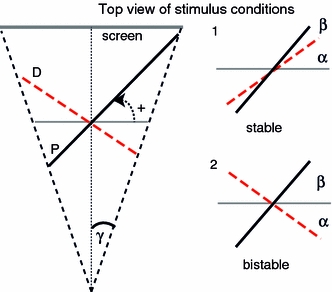Fig. 3.

a The subtended angle from center to left or right side of the stimulus was 10° (γ) irrespective of the imposed surface slants defined by disparity (D) and perspective (P). A counter clockwise rotation of the surface about the vertical axis is defined as a positive surface slant angle (+). b Examples of different stimulus conditions. The surface slant angle as defined by disparity was ±50° (α) and the perspective defined surface slant angle (β) was ± 70°. In the unambiguous stimulus, disparity and perspective defined the same surface orientation yielding a stable perception of surface slant (1). Whereas in the ambiguous stimulus condition (2), the orientations of the defined surfaces were opposite, giving a bistable perception of surface slant
